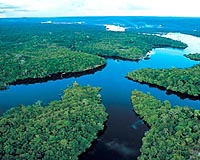 |
Pasadena CA (JPL) Aug 09, 2010 Drought and the worst heat wave Russia has seen in 130 years have sparked a devastating outbreak of wildfires across the nation this summer, primarily in the country's western and central regions. According to wire service reports and Russia's Emergency Situations Ministry, as of Aug. 6, 2010, some 558 fires were burning. The fires have killed at least 52 people, destroyed some 2,000 homes and charred more than 1,796 square kilometers (693 square miles). Russia's capital city of Moscow is currently blanketed in a thick smog, which has curtailed activities and disrupted air traffic. According to the Associated Press, levels of carbon monoxide pollution in Moscow are at an all-time high, four times higher than normal. The Atmospheric Infrared Sounder (AIRS) instrument on NASA's Aqua spacecraft is tracking the concentration and transport of carbon monoxide from the Russian fires. The figures presented here show the abundance of carbon monoxide present in the atmosphere at an altitude of 5.5 kilometers (18,000 feet). AIRS is sensitive to carbon monoxide in the mid-troposphere at heights between 2 and 10 kilometers (1.2 and 6.2 miles), with a peak sensitivity at an altitude of approximately 5 kilometers (3.1 miles). This region of Earth's atmosphere is also conducive to the long-range transport of the pollution that is lofted to this altitude. As shown in Figure 1, acquired July 21, 2010, the concentration of carbon monoxide from the fires on that date was largely limited to the European part of Russia (western and central Russia). This contrasts dramatically with the data in Figure 2, acquired on August 1, when the carbon monoxide concentration was much higher and the area of the fires had increased significantly. The concentration of carbon monoxide is continuing to grow. According to Aug. 4 NASA estimates, the smoke plume from the fires spans about 3,000 kilometers (1,860 miles) from east to west, approximately the distance from San Francisco to Chicago. Figure 3 shows changes in the total amount of carbon monoxide above western Russia in megatons through August 1, 2010 (shown by the red curve). The changes are plotted again the base year of 2009, which saw normal levels of seasonal carbon monoxide. This is contrasted against the year 2002, when peat fires predominated in Russia. The 2002 data are from the Measurements of Pollution in the Troposphere (MOPITT) instrument on NASA's Terra spacecraft. On August 1, 2010, the excess carbon monoxide content almost reached the maximum values seen in 2002. The rate of growth (approximately 0.7 megatons, or 700,000 metric tons, per day) characterizes the rate of emission; the current rate is approximately three times higher than in 2002.
Share This Article With Planet Earth
Related Links AIRS Earth Observation News - Suppiliers, Technology and Application
 Satellites help measure Earth's water
Satellites help measure Earth's waterColumbus, Ohio (UPI) Aug 6, 2010 Scientists say they've used satellite data to measure for the first time the amount of water that rises and falls in the Amazon River floodplain each year. Ohio State University researchers say the information is critical to predicting floods and droughts that might be brought about by global climate change, a university release said Friday. Until now, researchers trying to estim ... read more |
|
| The content herein, unless otherwise known to be public domain, are Copyright 1995-2010 - SpaceDaily. AFP and UPI Wire Stories are copyright Agence France-Presse and United Press International. ESA Portal Reports are copyright European Space Agency. All NASA sourced material is public domain. Additional copyrights may apply in whole or part to other bona fide parties. Advertising does not imply endorsement,agreement or approval of any opinions, statements or information provided by SpaceDaily on any Web page published or hosted by SpaceDaily. Privacy Statement |